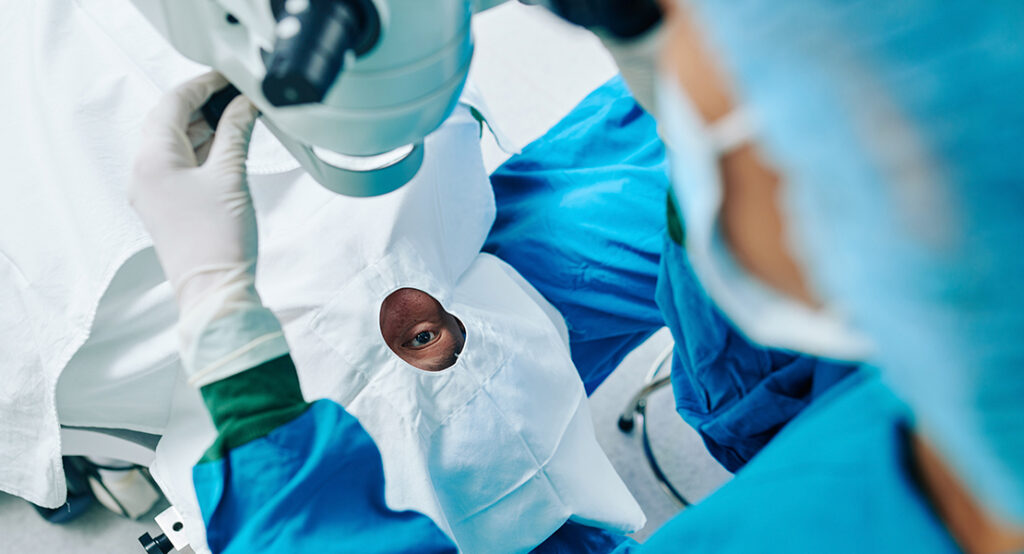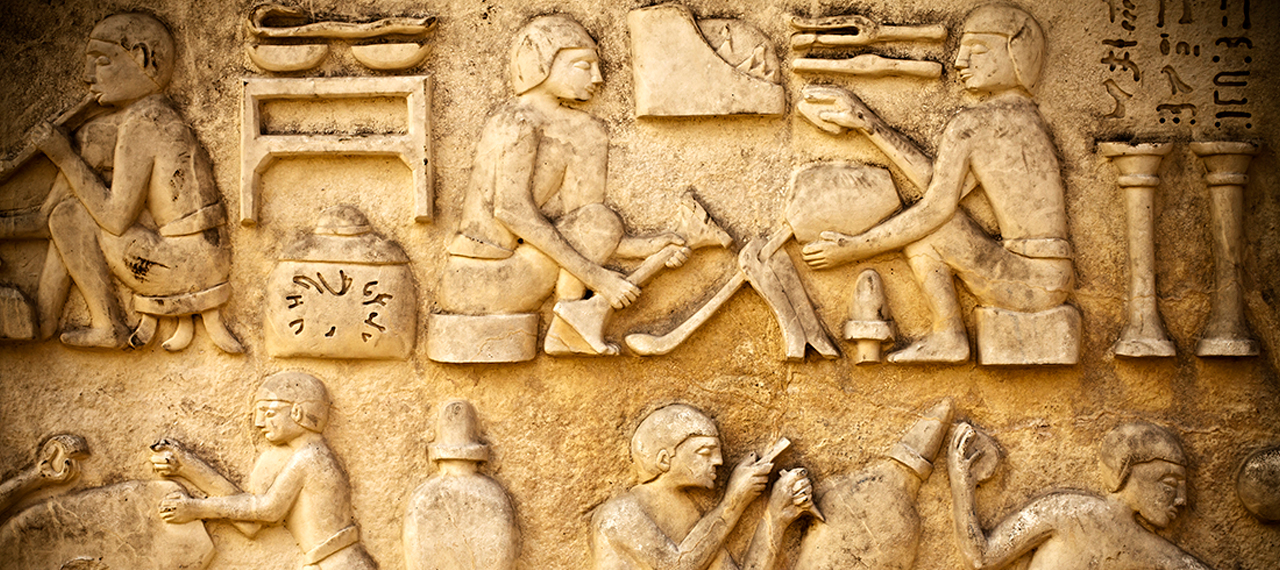Cataract surgery is one of the oldest known surgical procedures, with a history that spans thousands of years. From primitive techniques in ancient civilisations to the highly sophisticated procedures used today, the evolution of cataract surgery reflects remarkable advancements in medical science and technology. This article traces its journey from its earliest recorded practices to the present day.
Ancient Beginnings: The Couching Method
The first known records of cataract surgery date back to around 800 BCE in ancient India and Egypt. The earliest technique, known as couching, involved using a sharp instrument—often a needle or pointed stick—to dislodge the cloudy lens and push it deeper into the eye. This allowed light to enter the eye again, restoring partial vision but leaving the patient with significantly blurred sight due to the absence of a functional lens. Although crude, couching was practiced widely in ancient China, Greece, and Rome, becoming the predominant method for treating cataracts for centuries.
In Egypt, historical evidence suggests that physicians may have used metal or reed instruments specifically designed for couching, demonstrating an early attempt at surgical precision. Hieroglyphic inscriptions and medical papyri indicate that Egyptian healers understood the importance of eye health and had various herbal remedies to complement surgical interventions. Similarly, in India, ancient Sanskrit texts such as the Sushruta Samhita (circa 600 BCE) describe detailed procedures for couching, performed by skilled surgeons using finely crafted needles. The procedure was often followed by postoperative care, including herbal applications and bandaging, suggesting an early understanding of wound management.
The ancient Greek physician Hippocrates (460–370 BCE) documented early surgical methods, including rudimentary descriptions of eye operations, though much of his focus remained on holistic treatments. Later, Galen (129–216 CE) further explored ocular anatomy and proposed theories on visual function, laying the groundwork for later surgical refinements. His writings emphasized the importance of understanding eye structure, influencing medical practice across the Roman Empire and beyond. Additionally, Celsus (25 BCE–50 CE), a Roman medical writer, provided one of the most detailed early descriptions of couching, noting both its benefits and limitations.
Further advancements were seen in China, where couching was refined with the use of specially designed needles and the integration of acupuncture principles to aid in pain relief and recovery. Some Chinese medical texts suggest that cataract removal was combined with herbal treatments to reduce inflammation and promote healing.
Despite its limitations, couching remained the standard procedure for cataract treatment for nearly two millennia, persisting in various forms across different cultures. Over time, incremental refinements in technique and tool design set the stage for more advanced surgical methods that would emerge in the medieval and early modern periods.
Medieval and Islamic Contributions

During the Islamic Golden Age (8th–14th centuries CE), significant progress was made in ophthalmology, building upon knowledge from ancient Greek, Roman, and Indian medical traditions. The renowned Persian physician Al-Razi (Rhazes, 865–925 CE) wrote extensively about eye diseases, detailing various cataract symptoms, causes, and potential treatments. His writings emphasized the importance of early diagnosis and patient care, influencing medical practices for centuries.
Meanwhile, Al-Zahrawi (Abulcasis, 936–1013 CE), often regarded as the father of modern surgery, developed a range of surgical instruments specifically for ophthalmic procedures, including fine needles and scalpels designed to improve the precision of cataract operations. His surgical manual, Kitab al-Tasrif, described advanced techniques for treating eye conditions, some of which laid the groundwork for later developments in ophthalmology.
Another major figure, Ibn al-Haytham (Alhazen, 965–1040 CE), made crucial contributions to the understanding of optics, providing a scientific explanation of how light interacts with the eye. His book Kitab al-Manazir (Book of Optics) revolutionized the field by explaining the mechanism of vision and inspiring future generations of surgeons to refine their techniques. His findings influenced later European scientists and played a vital role in the advancement of cataract surgery.
One of the most significant innovations of this period was the improvement of the couching technique, with Islamic physicians introducing the use of hollow needles to extract the clouded lens rather than merely pushing it aside. This was a precursor to the lens extraction techniques that would later evolve into more sophisticated cataract surgeries. Physicians in the Islamic world also placed greater emphasis on post-operative care, recommending herbal treatments and bandaging techniques to reduce infection risks and improve recovery outcomes.
As Islamic medical knowledge spread across Europe via translations of Arabic texts, these advancements greatly influenced the development of cataract surgery in the medieval and early modern periods.
The Renaissance and Early Modern Period

By the 17th and 18th centuries, European physicians began refining cataract surgery techniques, shifting away from traditional couching methods. The French surgeon Jacques Daviel (1696–1762) is credited with performing the first extracapsular cataract extraction (ECCE) in 1747, a groundbreaking departure from previous techniques. Unlike couching, which merely displaced the cloudy lens, ECCE involved making an incision and removing the cataractous lens in one piece, significantly improving visual outcomes for patients. Daviel’s approach laid the foundation for modern cataract extraction and was widely studied and refined in subsequent years.
This period also saw increased experimentation with surgical tools and incision methods. Surgeons sought to improve precision and reduce post-operative complications, leading to more controlled incisions and better wound management. Advancements in ophthalmic instruments, such as finer scalpels and speculums, allowed for greater accuracy and less damage to surrounding eye structures.
During the 19th century, further innovations in surgical techniques and medical hygiene drastically improved patient outcomes. The introduction of antiseptic methods revolutionised surgery, drastically reducing the risk of post-operative infections. Karl Ferdinand von Graefe (1787–1840) introduced key modifications to ECCE, refining incision techniques to minimise trauma and promote faster healing. He also advocated for better post-operative care, emphasising cleanliness and wound management.
Meanwhile, Albrecht von Graefe (1828–1870) played a crucial role in enhancing surgical precision. He developed specialised instruments, such as the von Graefe knife, which allowed for more controlled incisions during cataract extraction. His contributions marked a major step towards safer, more effective cataract surgery, reducing both the risk of infection and post-operative complications.
Another critical development during this period was the growing understanding of ocular anatomy and physiology, which helped surgeons refine their techniques further. The 19th century also saw the first successful attempts at suturing surgical incisions, allowing for better healing and stability post-surgery. These incremental advances set the stage for the revolutionary developments of the 20th century.
The 20th Century: Introduction of Intraocular Lenses (IOLs)
A groundbreaking development in cataract surgery came in 1949, when British ophthalmologist Sir Harold Ridley pioneered the use of intraocular lenses (IOLs). His innovation was inspired by his observations during World War II, where he noted that pilots with acrylic fragments embedded in their eyes from aircraft canopies experienced no adverse reactions. Recognising the potential for artificial lens implants, Ridley developed the first PMMA (polymethyl methacrylate) intraocular lens, which could replace the removed cataractous lens and restore clearer vision.
Initially, IOLs were met with scepticism, but over time, advancements in biocompatibility and surgical implantation techniques led to their widespread adoption. By the 1960s, improvements in lens design and implantation methods had made IOLs a viable and preferred option for cataract patients.
The 1960s and 1970s witnessed another transformative innovation with the introduction of phacoemulsification by Charles Kelman in 1967. This revolutionary technique used ultrasound waves to break up the cataract into smaller fragments, which were then suctioned out through a tiny incision. Unlike previous methods that required larger incisions and longer recovery times, phacoemulsification allowed for smaller incisions, faster healing, and fewer complications.
Kelman’s technique significantly reduced surgical trauma and transformed cataract surgery into a minimally invasive procedure. With smaller incisions, the need for sutures decreased, leading to faster recovery and improved patient comfort. This technique quickly became the gold standard for cataract surgery and remains the dominant approach today.
By the late 20th century, further innovations in IOL technology introduced foldable lenses, allowing surgeons to insert the lens through even smaller incisions. These foldable IOLs provided better post-operative vision and increased surgical efficiency. Additionally, advancements in laser technology, imaging techniques, and computer-assisted surgery further refined the procedure, making cataract surgery one of the safest and most successful surgical interventions in modern medicine.
The continued development of IOLs, along with refinements in femtosecond laser-assisted surgery, has ensured that cataract surgery remains at the forefront of medical advancements, offering improved visual outcomes and a better quality of life for millions of patients worldwide.
Cataract Surgery Today

Modern cataract surgery is a highly refined and precise procedure, benefiting from continuous advancements in medical technology. Small-incision phacoemulsification remains the most widely used technique, allowing for the efficient removal of cataracts with minimal trauma to the eye. This approach has significantly reduced recovery times, enabling many patients to return to their normal activities within days rather than weeks.
The introduction of femtosecond laser-assisted cataract surgery (FLACS) has further enhanced precision by automating key steps of the procedure, including corneal incisions, capsulotomy, and lens fragmentation. By reducing manual variability, FLACS improves surgical accuracy, leading to better visual outcomes and fewer complications. This technology is particularly beneficial for patients with complex cataracts or those requiring highly precise lens placement.
Intraocular lens (IOL) technology has also advanced considerably, offering patients greater personalisation and improved vision correction. Traditional monofocal lenses provide clear distance vision but require reading glasses for near tasks. However, modern multifocal, trifocal, and extended depth-of-focus (EDOF) lenses allow patients to see at multiple distances with minimal dependence on glasses. Additionally, toric lenses have been developed to correct astigmatism, providing sharper vision for those with irregular corneal curvature.
Beyond lens advancements, robotic assistance and AI-driven diagnostics are transforming the planning and execution of cataract surgery. AI-powered imaging systems can analyse the eye with unprecedented precision, helping surgeons tailor treatments to each patient’s unique anatomy. Meanwhile, robotic-assisted platforms improve the accuracy of incisions and lens positioning, further minimising surgical risks.
Customisable lens implants, including light-adjustable lenses (LALs), now enable post-operative adjustments to fine-tune vision after surgery. These lenses can be modified using ultraviolet light to optimise focus, offering patients even greater control over their final visual outcomes.
With these continuous innovations, cataract surgery today is safer, more efficient, and more effective than ever before. As technology progresses, the procedure is expected to become even more tailored to individual patient needs, further improving visual outcomes and enhancing overall quality of life.
Conclusion
The history of cataract surgery is a testament to human ingenuity and medical progress. From the rudimentary couching methods of ancient Egypt to today’s sophisticated laser-assisted techniques, the journey of cataract surgery highlights the relentless pursuit of better vision and improved quality of life for millions worldwide. With ongoing advancements, the future of cataract surgery promises even greater precision and accessibility for patients across the globe.

